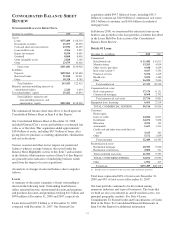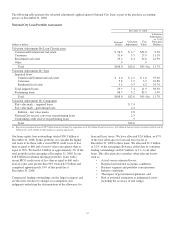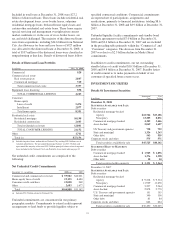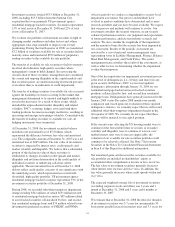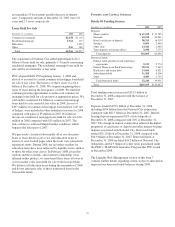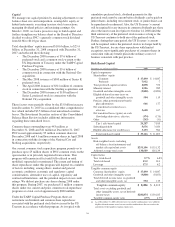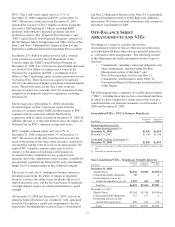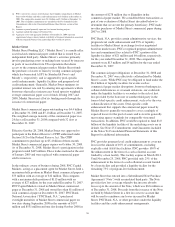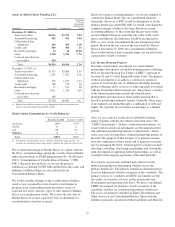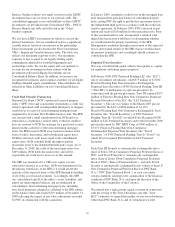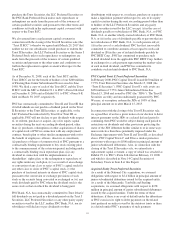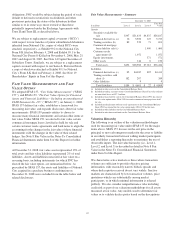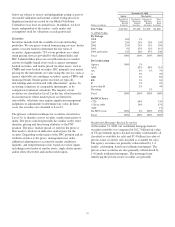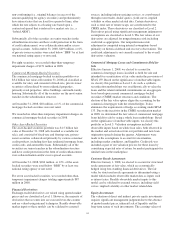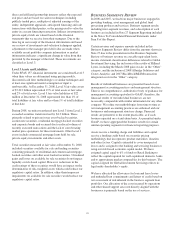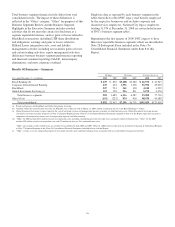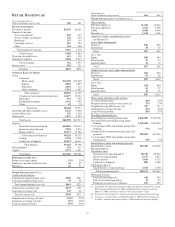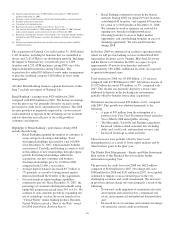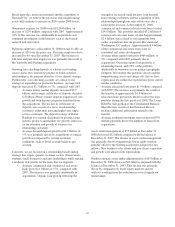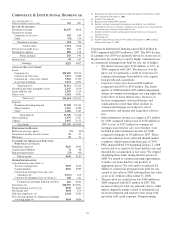PNC Bank 2008 Annual Report Download - page 44
Download and view the complete annual report
Please find page 44 of the 2008 PNC Bank annual report below. You can navigate through the pages in the report by either clicking on the pages listed below, or by using the keyword search tool below to find specific information within the annual report.Interest. Neither creditors nor equity investors in the LIHTC
investments have any recourse to our general credit. The
consolidated aggregate assets and liabilities of these LIHTC
investments are provided in the Consolidated VIEs – PNC Is
Primary Beneficiary table and reflected in the “Other”
business segment.
We also have LIHTC investments in which we are not the
primary beneficiary, but are considered to have a significant
variable interest based on our interests in the partnership.
These investments are disclosed in the Non-Consolidated
VIEs – Significant Variable Interests table. The table also
reflects our maximum exposure to loss. Our maximum
exposure to loss is equal to our legally binding equity
commitments adjusted for recorded impairment and
partnership results. We use the equity and cost methods to
account for our investment in these entities with the
investments reflected in Equity Investments on our
Consolidated Balance Sheet. In addition, we increase our
recognized investments and recognize a liability for all legally
binding unfunded equity commitments. These liabilities are
reflected in Other Liabilities on our Consolidated Balance
Sheet.
Credit Risk Transfer Transaction
National City Bank (“NCB”) sponsored a special purpose
entity (“SPE”) trust and concurrently entered into a credit risk
transfer agreement with an independent third-party to mitigate
credit losses on a pool of nonconforming mortgage loans
originated by its former First Franklin business unit. The SPE
was formed with a small contribution from NCB and was
structured as a bankruptcy-remote entity so that its creditors
have no recourse to NCB. In exchange for a perfected security
interest in the cash flows of the nonconforming mortgage
loans, the SPE issued to NCB asset-backed securities in the
form of senior, mezzanine, and subordinated equity notes.
NCB has incurred credit losses equal to the subordinated
equity notes. NCB currently holds the right to put the
mezzanine notes to the independent third-party at par. As of
December 31, 2008, the value of the mezzanine notes was
$169 million. NCB holds the senior notes and will be
responsible for credit losses in excess of this amount.
The SPE was deemed to be a VIE as its equity was not
sufficient to finance its activities. NCB was determined to be
the primary beneficiary of the SPE as it would absorb the
majority of the expected losses of the SPE through its holding
of all of the asset-backed securities. Accordingly, this SPE
was consolidated and all of the entity’s assets, liabilities, and
equity are intercompany balances and are eliminated in
consolidation. Nonconforming mortgage loans, including
foreclosed properties, pledged as collateral to the SPE remain
on the balance sheet and totaled $719 million at December 31,
2008 reflecting the impact of fair value adjustments recorded
by PNC in conjunction with the acquisition.
In January 2009, cumulative credit losses in the mortgage loan
pool surpassed the principal balance of subordinated equity
notes, giving PNC the right to put the first mezzanine note to
the independent third party in accordance with the credit risk
transfer agreement. In February 2009, PNC exercised its put
option and received $16 million for the mezzanine note. Prior
to this reconsideration event, management evaluated what
impact this transaction would have on determining whether
we would remain the primary beneficiary of the SPE.
Management concluded, through reassessment of the expected
losses and residual returns of the SPE, that we would remain
the primary beneficiary and accordingly should continue to
consolidate the SPE.
Perpetual Trust Securities
We issue certain hybrid capital vehicles that qualify as capital
for regulatory and rating agency purposes.
In February 2008, PNC Preferred Funding LLC (the “LLC”),
one of our indirect subsidiaries, sold $375 million of 8.700%
Fixed-to-Floating Rate Non-Cumulative Exchangeable
Perpetual Trust Securities of PNC Preferred Funding Trust III
(“Trust III”) to third parties in a private placement. In
connection with the private placement, Trust III acquired $375
million of Fixed-to-Floating Rate Non-Cumulative Perpetual
Preferred Securities of the LLC (the “LLC Preferred
Securities”). The sale was similar to the March 2007 private
placement by the LLC of $500 million of 6.113%
Fixed-to-Floating Rate Non-Cumulative Exchangeable Trust
Securities (the “Trust II Securities”) of PNC Preferred
Funding Trust II (“Trust II”) in which Trust II acquired $500
million of LLC Preferred Securities and to the December 2006
private placement by PNC REIT Corp. of $500 million of
6.517% Fixed-to-Floating Rate Non-Cumulative
Exchangeable Perpetual Trust Securities (the “Trust I
Securities”) of PNC Preferred Funding Trust I (“Trust I”) in
which Trust I acquired $500 million of LLC Preferred
Securities.
Each Trust III Security is automatically exchangeable into a
share of Series J Non-Cumulative Perpetual Preferred Stock of
PNC, each Trust II Security is automatically exchangeable
into a share of Series I Non-Cumulative Perpetual Preferred
Stock of PNC (“Series I Preferred Stock”), and each Trust I
Security is automatically exchangeable into a share of Series F
Non-Cumulative Perpetual Preferred Stock of PNC Bank,
N.A. (“PNC Bank Preferred Stock”), in each case under
certain conditions relating to the capitalization or the financial
condition of PNC Bank, N.A. and upon the direction of the
Office of the Comptroller of the Currency.
We entered into a replacement capital covenant in connection
with the closing of the Trust I Securities sale (the “Trust
RCC”) whereby we agreed that neither we nor our subsidiaries
(other than PNC Bank, N.A. and its subsidiaries) would
40



